|
|
Post by codystarbuck on Jun 8, 2017 21:43:37 GMT -5
I was just reading through a book on WW2 weapons, which had an article on the Henschel HS 293 and saw that the Germans actually drafted a plan to launch a V2 rocket from a towed container, transported by a submarine, against New York City. The plan was never implemented; but, the psychological effect if they had carried it out would have been devastating. I wonder if Kirby had read about that or just about the Henschel and their use in the Mediterranean and just came up with the plot?
|
|
|
|
Post by codystarbuck on Jun 10, 2017 17:21:55 GMT -5
Our Fighting Forces #157-158   Our story opens in tropical Panama, home of the hat , Yellow Fever, the Canal and Panama Fattie... 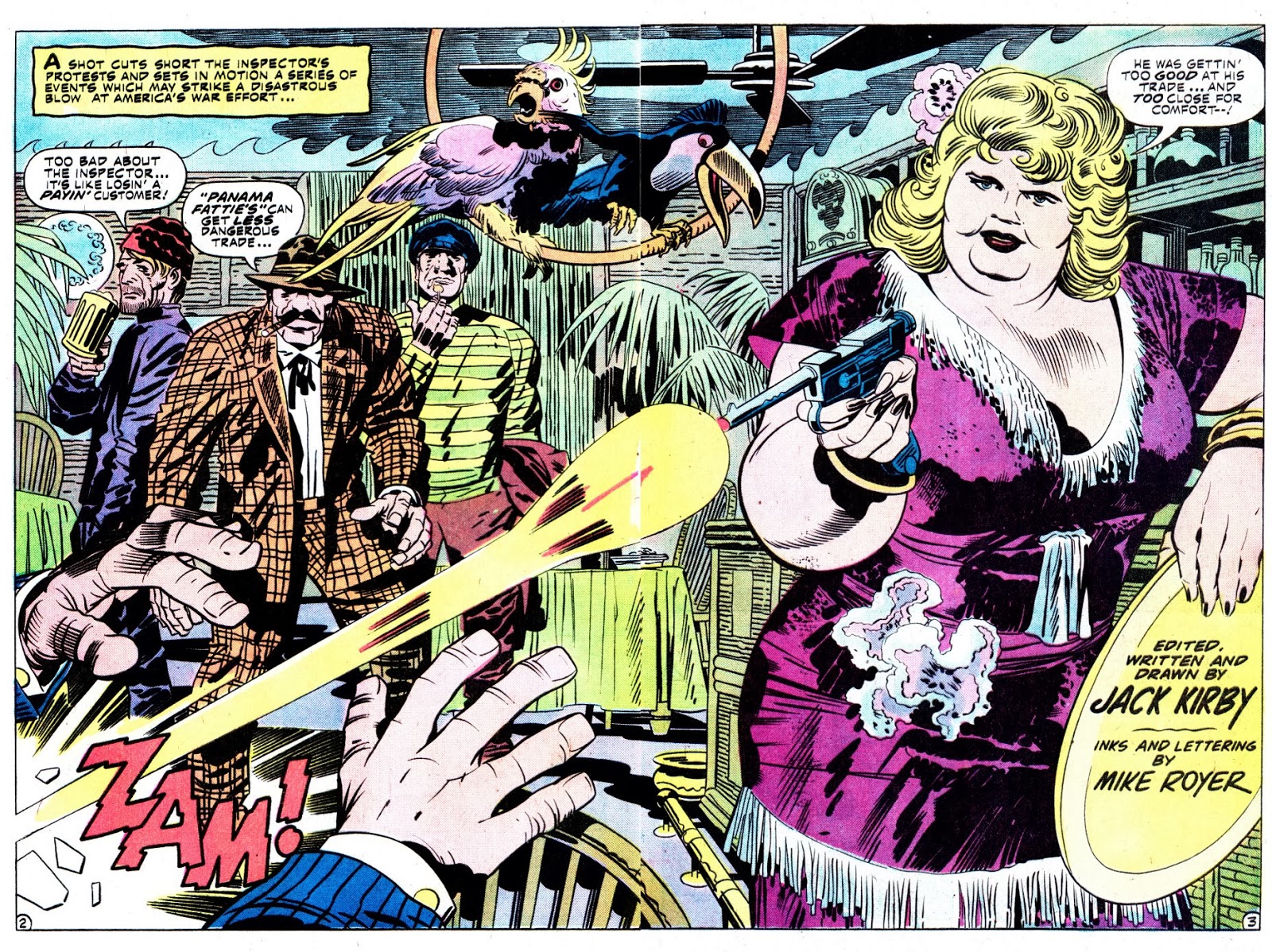 PF has just killed an inspector, who was getting too close to her operation. Meanwhile, one of her "boys" actually hits on her and gets decked. She comes off like Sydney Greenstreets more dangerous (and active) sister. Meanwhile, the Losers are in the Cnal Zone and have been assigned to the Navy, to look into hijackings of supplies and equipment. The gang are all dressed in Navy uniforms and they are driving along a little-used road, when they come across a damsel in distress. her car is stuck and she asks for help. Storm and Cloud go to lend a hand and PF's men move in behind the truck. They pull back the tarp and Gunner and Sarge come blasting out. A fight ensues and PF is about to pull a gun and shoot Storm; but, she can't do it! It seems that no dame is immune to the power of a Naval Officer's uniform (so true......)! She helps the Losers chase off the bandits, then makes advances on Storm. She directs the men to her club to repay their kindness At the club, Storm takes issue with the others calling her Fattie and even punches Sarge over it (uh-oh, that's a court martial offense!). Sarge feels funny and goes down, as do the rest. Fattie slipped them a mickey! She tells her goons to take them to her warehouse but not to kill them. meanwhile, she delivers supplies to a Lt. Nakamura, of the Imperial Japanese Navy! he hands her the final payment and she is happy and rich. The Losers are aghast and she tells Storm it is a shame that she has to kill them. her boys take aim as the issue ends. The next issue opens with the secret of the Japanese Navy presence: a Yokusuka p1-Y1 Ginga bomber, known as a "Frances" to the Allies... 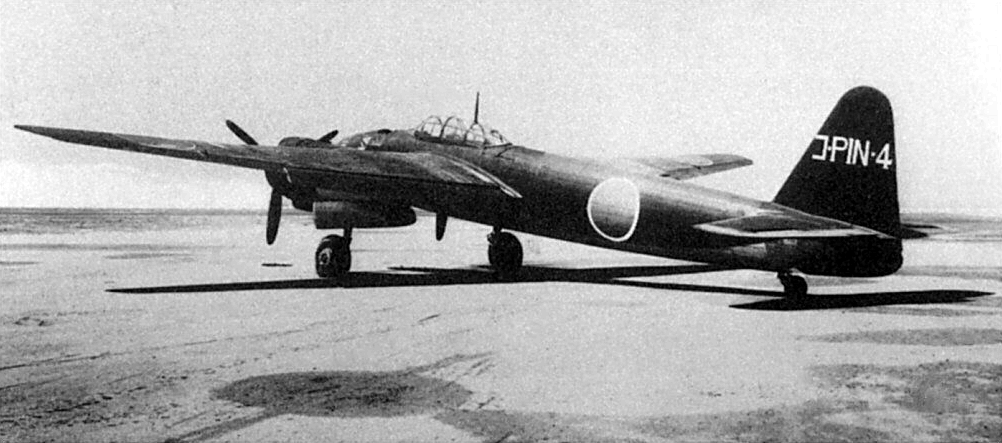 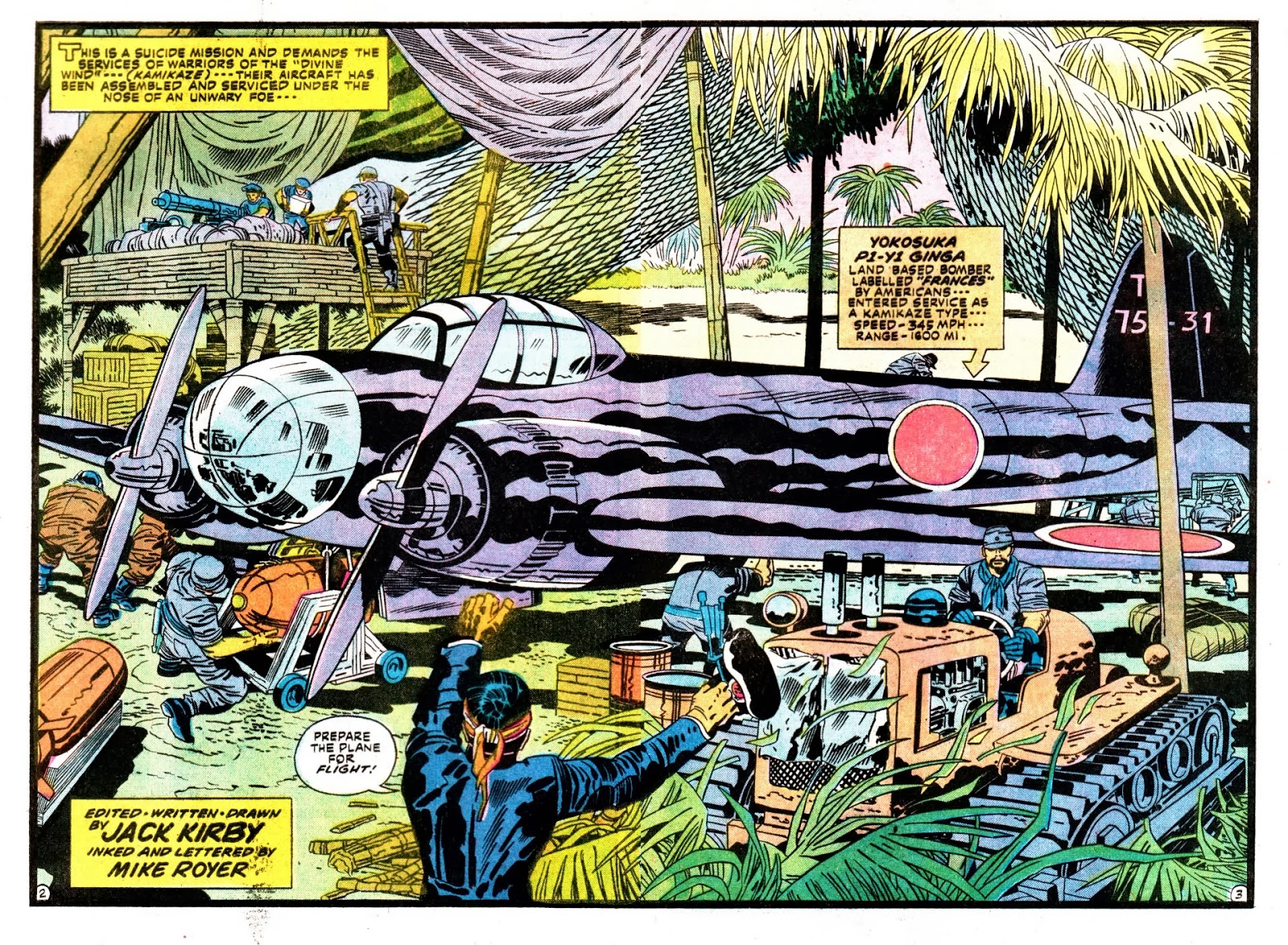 The plan is for the plane to fly a kamikaze mission to wreck the Panama Canal. The details are never given in the issue; but, the best way to do it is to fill the plane full of explosives and fly it into one of the locks, detonating the explosives and crippling the lock. That would prevent further use of the lack, blocking off the canal until it could be prepared. The plane is moved into position and Fattie's men are ready to shoot. Storm tries to reason with her but greed holds greater sway. Sarge demands a last cigarette and uses the diversion to launch an attack. The Losers fight, while still bound and once again, Fattie can't shoot Storm. She takes it on the lam with the loot and leaves her men to face the battling Losers. They fight their way free and really do some damage, then go after Fattie. Storm has a bead on her but can't shoot. Cloud is able to shoot out the tires and she heads into the jungle. They follow and see her reach the hidden Japanese base, where she demands entry. The guard stops her and she shoots him! The Japanese fire back, mortally wounding her. The Losers use the diversion to launch their attack. Storm finds Fattie and they share last words. the others battle to get near the bomber, which is taking off. Finally, Gunner is able to get a bead on it wit a water-cooled .30 cal machine gun and succeeds in igniting a fuel tank, destroying the plane as it was rising. Exciting pair of issues as Kirby throws some mystery, action, and even some romance into things. The romantic angle seems a bit ridiculous, at first; but, it actually becomes a bit touching, as Storm actually returns PF's affection. Kirby combines his experience with romance comics (he and Joe Simon created them), crime stories, and war comics to make a rather unique tale. Kirby actually presents a complex character in Lil, aka Panama Fattie. he men and everyone else see the fat woman and gangster; but, Storm sees Lil and it takes her back a bit. This being a war comic, Kirby can't really expand upon it, the way other writers might; but, it is rather unique, for the period. Kirby was known for his zoftig women and even Roz said he liked his women.....healthy. As his art evolved, his women tended to be more full figured; so, it isn't surprising that he creates a large woman as both an enemy and an almost-sympathetic character. Definitely not your usual war comic. An attack on the Panama Canal by the Japanese was not far fetched (nor the Germans, for that matter). Because of its strategic importance (much of the US shipyard capability was on the Atlantic coast and ships would have to transit the Canal to head into the Pacific), there was a large land and sea presence there, by the Allies. Heavy patrols hunted for submarines, looking to attack ships headed into the Canal Zone. The Japanese actually developed a class of submarine to carry out such an attack: the I-400 Class Submarine. 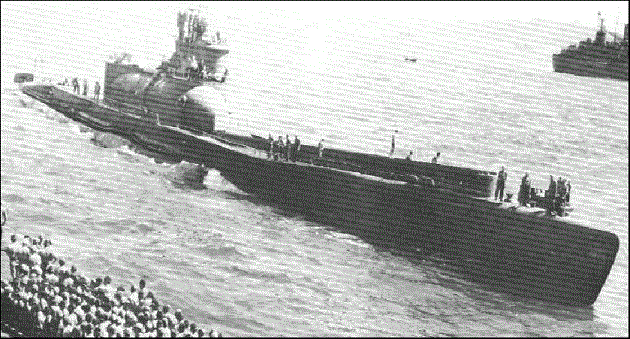 The submarine was the largest conventionally powered submarine class ever built, prior to nuclear propulsion. They carried enough fuel to circumnavigate the globe, let alone reach the US. The subs had a watertight hanger that could be retracted and in which were carried 3 Aichi M6A Seiran floatplanes. 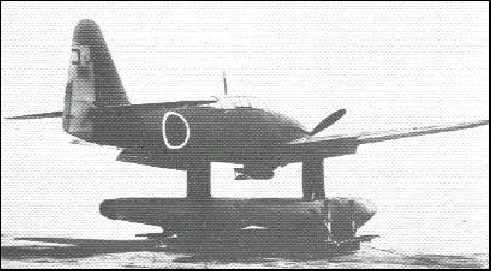 These planes could carry torpedoes or conventional bombs, more than enough to disable a lock. The plan called for two of the submarines to sail with two from another class (retrofitted with two planes each) be sent to attack the Canal, with 10 planes available for the strike. At first, the idea was to bomb, then it was altered to be a kamikaze attack, though that knowledge was withheld from the pilots. One pilot figured it out when he saw that the bomb release mechanism had been removed from his plane and confronted the squadron XO, who explained the rationale of withholding the info, to keep pressure off the pilots, during their training. Training proceeded but fate intervened. When the Marines took Okinawa and were preparing to attack the Japanese home islands, the Navy saw the futility of the attack. Instead, a new mission was conceived to launch a biological weapon attack on San Diego, which would spread up the coastline. The plan was set to be carried out in September of 1945. However, fate again intervened and the Japanese surrendered in August, after the dropping of the atomic bombs on Hiroshima and Nagasaki. The US Navy boarded and recovered 24 submarines and were inspecting them, when they heard the Russians had sent examiners. not wanting the catapult technology and other advances to fall into Soviet hands, they scuttled most of the ships and sailed 4 back to Hawaii for study. When these studies were finished, they were sunk off the coast of Hawaii. Another attack was planned, against the forces massing at Ulithi Atoll, for the invasion of Japan. The idea was to attack the base, with the M6A seaplanes painted with US markings, to further aid penetration of defenses. Again, the Japanese surrender occurred before the attack took place. |
|
|
|
Post by codystarbuck on Jun 10, 2017 17:46:12 GMT -5
Our Fighting Forces #159  This issue features the story of "Mile-a-Minute Jones," an African-American soldier who competed in the 1936 Berlin Olympics.  I'm going to do something different with this one. I'm going to let the King tell his story... The German escapes and Jones chases after him, across a field. They follow the white tape, like it is a lane marker. Jones is catching up, but the German is running for all he is worth. Jones makes a desperate leap to stop the German and misses, as he crosses the line, alerting the other members of his fallschirmjager (paratrooper) platoon. They move in skirmish line across the field and detonate the minds. Cloud yells at Jones to stay put and then directs him to the tape, the only safe path. The team heads out with their prize, a captured German general, as air support arrives to hold off the Germans and carry the Losers out, their prisoner in tow. Jones realizes that his fantasy of running a race and following the engineer's tape saved his life; but, he losy a competitor who he almost considered a friend. Years before, Robert Kanigher and Joe Kubert did a similar story, with Sgt Rock and Easy Company member Jackie Johnson. Johnson was a champion boxer, who meets up with a former German opponent (mirroring Joe Louis and Max Schmelling). Easy Company is captured and Jones is forced to fight, though an attack comes and the Germans are routed. The German boxer's life is saved by Jones' blood, via a transfusion. he finds that he owes his life to someone he considered inferior. |
|
|
|
Post by Prince Hal on Jun 12, 2017 13:53:38 GMT -5
codystarbuck, as much as I loved your Tarzan thread, I am enjoyong the hell out of this section on Kirby's Losers! Keep up the historical tie-ins, which even to someone who has read a great deal about the era, are fascinating. A few things about The Losers always bugged me, not the least of which were the way they were thrown together in the first place, and the uniforms and command issues you write about so well. It was almost as if Kanigher or whoever had an idea for a misfit bunch of operatives, but felt that they needed some "name-brand" recognition, thus the gimmick of uniting a bunch of canceled characters in one strip. I suppose it worked, though I wonder how many fans of the Losers had originally been fans of any of the members. Gunner and Sarge, Johnny Cloud, Captain Storm last appeared as lead features in June '65, July '66 and January '67 respectively. The first Losers isssue of OFF came out in November of '69. Quite a gap. Kanigher must not have subscribed to the Weisinger theory of how long fans stuck around.
|
|
|
|
Post by codystarbuck on Jun 12, 2017 22:09:43 GMT -5
codystarbuck , as much as I loved your Tarzan thread, I am enjoyong the hell out of this section on Kirby's Losers! Keep up the historical tie-ins, which even to someone who has read a great deal about the era, are fascinating. A few things about The Losers always bugged me, not the least of which were the way they were thrown together in the first place, and the uniforms and command issues you write about so well. It was almost as if Kanigher or whoever had an idea for a misfit bunch of operatives, but felt that they needed some "name-brand" recognition, thus the gimmick of uniting a bunch of canceled characters in one strip. I suppose it worked, though I wonder how many fans of the Losers had originally been fans of any of the members. Gunner and Sarge, Johnny Cloud, Captain Storm last appeared as lead features in June '65, July '66 and January '67 respectively. The first Losers isssue of OFF came out in November of '69. Quite a gap. Kanigher must not have subscribed to the Weisinger theory of how long fans stuck around. I hope that was a joke, 'cause it came up on the Jaimie Award nominations: I did not create the Tarzan thread; that was Michael James. I'd love to take credit; but, it's not mine.  Anyway, thanks for the kind words. i am a history buff, and like to throw in that stuff; but, I tend to go on when most people's eyes have glazed over. As soon as I wrap up Kirby and the Losers, I want to start a war comic review thread, covering various books, from Frontline Combat and Two-Fisted Tales, to Sgt Rock and Enemy Ace, to Sgt Fury a Capt Stryker, to Blazing Combat, The Lonely War of Willy Schultz, The Nam, Vietnam Journal, Semper Fi, Battlegroup Peiper, A Sailor's Story, etc, etc..... A few years ago I acquired scans of a huge chunk of that and it will give me an excuse to go poking around in them. I also have some British war comics, so Charley's War and Jacques Tardi may turn up, as well. Kanigher wasn't the greatest stickler for authenticity (though he was better about it than Stan or Gary Friedrich) and my research doesn't indicate that he served in the military (though he could have done a peacetime 2-year hitch, without mention of it, I suppose). I think the idea was that these guys had all had their comics cancelled and he just decided to throw them together. The Losers tage referred to the idea that they were all somehow cursed. Storm had been injured and lost a leg and an eye (I don't think Kirby knew about the wooden leg). Cloud had been shot down. I can't remember what the tragedy was for Gunner and Sarge (probably last guys left alive, or something similar). Kirby left Pooch out of things, though he had been a regular fixture in Losers stories. The face of it makes no sense: an Army fighter pilot, a Navy PT boat skipper, and two Marines. Why would you form a mission around them? In the thread about the series you'd like to write, I mentioned a Greatest Generation with the DC war comic characters (minus the stuff like Creature Commandos). For the Losers, I could see a team like the Alamo Scouts. They did behind the lines reconnaissance and POW rescue (the famed Cabanatuan Raid, in the Philippines). Gunner & Sarge could be Marine Raiders, who had been part of Carlson's Raiders. I would shift Cloud from the Army Air Force to the Marines, as a pilot. His Navajo background would create a code-talker role for him and he could pilot a seaplane to insert the team. All Marine officers, including pilots, are first trained as infantry officers, before moving on to specialized training; so, he'd have the right mix of skills. Make Storm a Navy liason, for PT Boat insertions; or, make him UDT. That would make more sense. |
|
|
|
Post by Prince Hal on Jun 13, 2017 5:40:15 GMT -5
codystarbuck, I was mocking myself there b/c of my previous gaffe.  IIRC, RK basically retconned the notion that each of these guys was a "loser, " though there was always a bit of that kind of aura around Capt. Storm.
|
|
|
|
Post by codystarbuck on Jun 13, 2017 10:46:31 GMT -5
codystarbuck , I was mocking myself there b/c of my previous gaffe.  IIRC, RK basically retconned the notion that each of these guys was a "loser, " though there was always a bit of that kind of aura around Capt. Storm. Yeah, I did a little poking around. Each suffers a tragedy, in the story that brings them together, and feels cursed, that they are "losers." They are brought together via Jeb Stuart, of the Haunted Tank and they then adopt that name, though they continue to make joking reference to their bad luck. According to Mark Evanier, Kirby hated the name, but was stuck with it. Capt. Storm was probably the least successful of the bunch, since he was created to cash in on John F Kennedy's fame. That's never a good formula for long term success. Kanigher's stories utilized the wooden leg regularly, with Joe Kubert making it a central feature of many covers. |
|
|
|
Post by codystarbuck on Jun 14, 2017 14:29:37 GMT -5
Our Fighting Forces #160  Kirby is gone from the cover and I believe he was gone from DC. It appears that his later work, with covers by other people (often Joe Kubert) were stories printed after he left. The only other times he didn't do the covers were in the Jimmy Olsen books, when the editors shot them down. Our story takes place in the Soviet Union, in territory controlled by the Germans. The focus of our story is a young Russian (possibly a Ukranian, though Kirby never states), named Ivan, who is part of the Allegemeine SS, the auxiliary of the SS. These were the troops who ran the concentration camps and did other SS dirty work, while the Waffen SS provided combat troops. Ivan is part of a firing squad, manning an MG-34 machine gun. 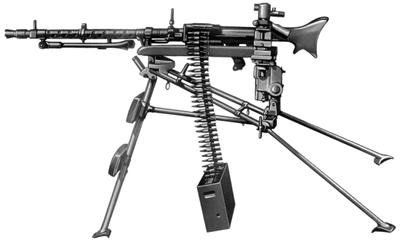 We watch as innocents are brutally gunned down... 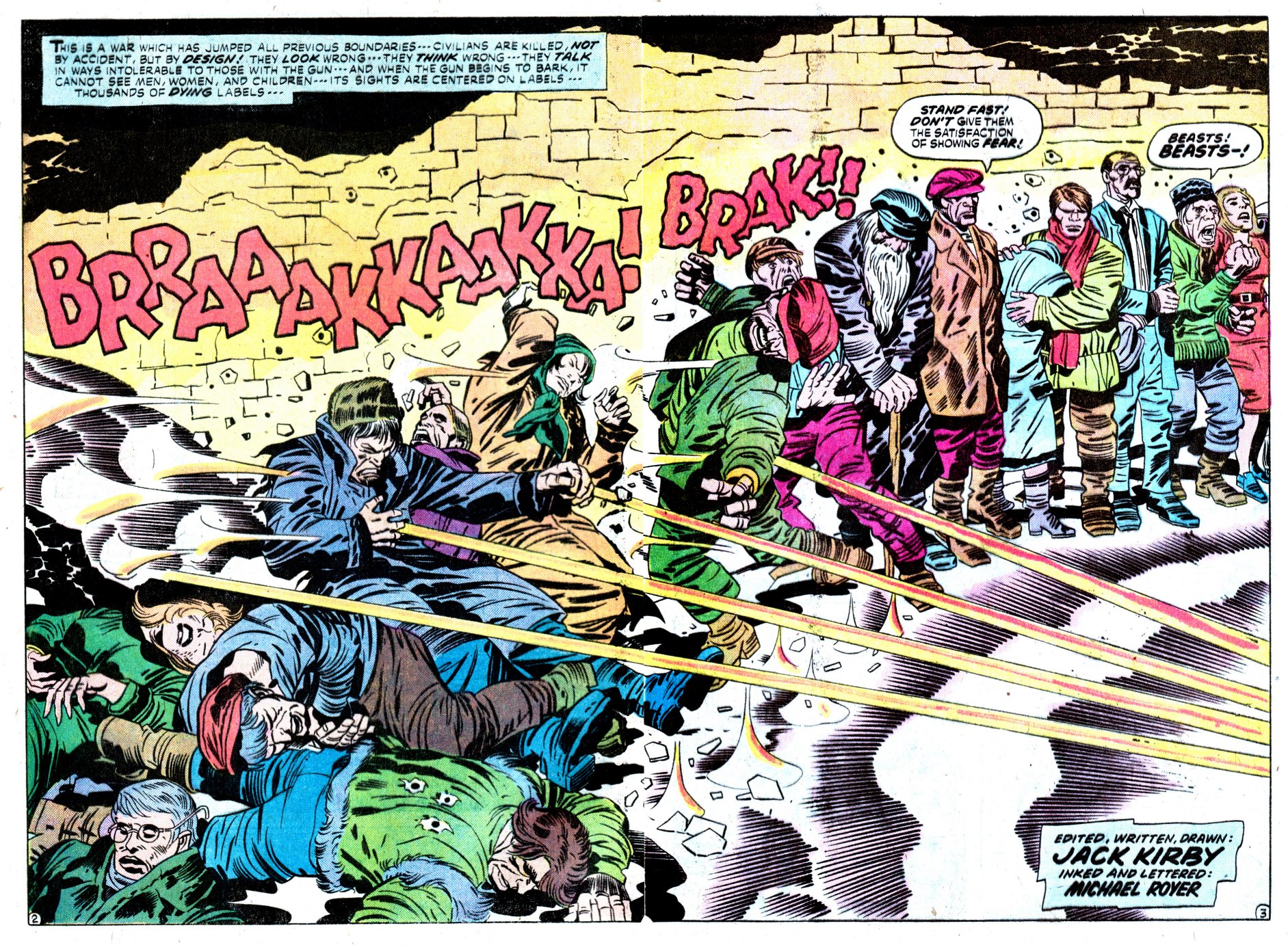 Ivan is sloppy in his work and some are left alive, to be given the coupe de grace by a friend, with a Walther P-38. Our scene shifts to a Russian home, where we find the Losers, disguised as SS officers (Cloud & Storm, while Gunner & Sarge wear the ranks of enlisted personnel). They are fed by a Russian woman, while keeping their cover. They are there to link up with the Russians, to deliver communications; but, the area had been overrun by the Germans. Ivan appears on the scene, in awe of the "SS officers." He lights Cloud's cigarette with a gold lighter that he got from a prisoner. Cloud and Storm leave him and we soon see how big of a scumbag Ivan is, and how much worse his mother is. They have civilians hiding in their cellar, who have given them all their valuable possessions in exchange for passes to escape the German advance. It is never overtly stated, but, the context suggests they are Jews. Ivan and his mother have taken everything and want still more. Ivan's mother has him beat one of the victims, to find out if he has more hidden away. Another gives him his coat and hat. Ivan threatens them that he is all that is keeping them safe from the orders "Not even the children will be spared." Sarge overhears this and decides he is going to do something about it. Storm cautions that their mission takes priority; but, the consensus is they can fulfill it and end this suffering. They find Ivan's stash of the booty he has taken from refugees and it stiffens their resolve. Storm spots an SS unit approaching the house and Cloud says to follow his lead. They let in the detail, who are surprised to find officers billeted there. Cloud directs them to the cellar and the Losers wait for the detail to mass around the door. The Losers then open fire, gunning down the entire unit. 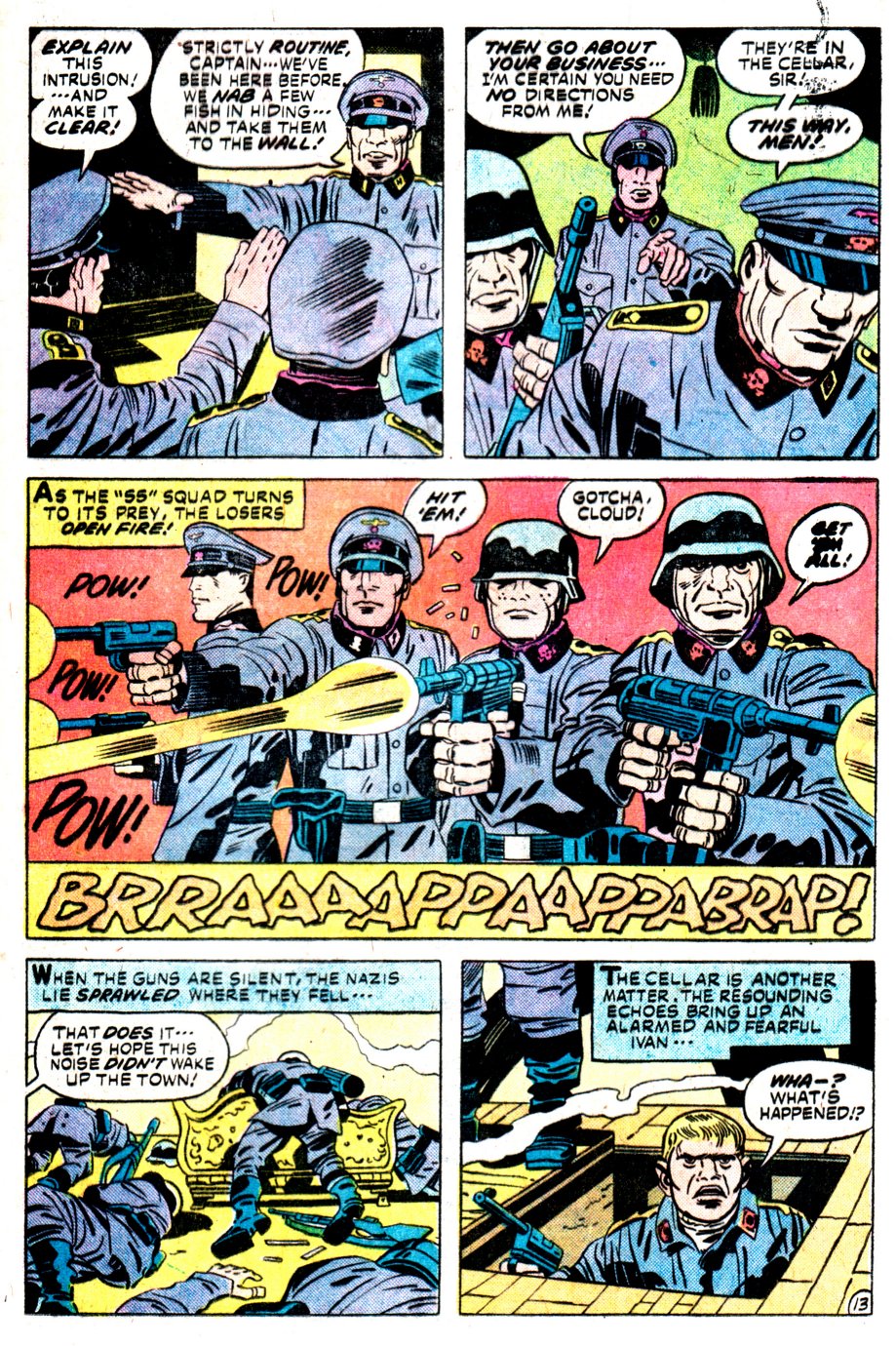 The refugees are led out to safety and Ivan is left to face his just deserts... 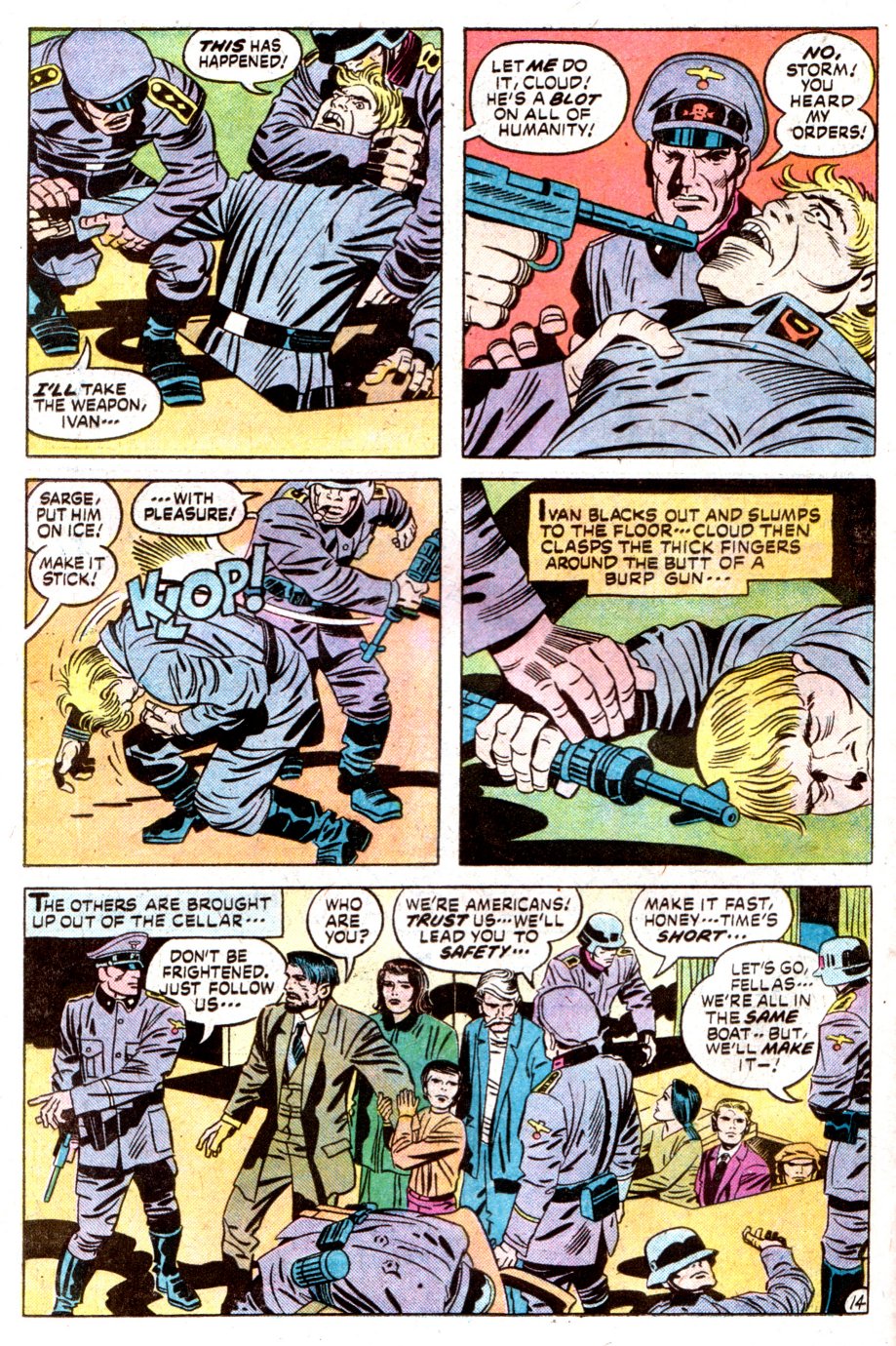 Ivan finds himself in front of the same firing squad he once manned, screaming his innocence as machine guns are trained upon him. Very powerful story from Kirby, showing that much of the evil from the Nazi regime came not just from Germany; but from like-minded people in occupied territories. Many people from Nazi-controlled territory joined local branches of the SS and fought on the Eastern Front, against the Russians. Others, such as the French Milice, a Vichy organizati, helped fight the Maquis resistance units. Many Dutch men joined the Dutch SS to fight the Russians, as seen in Paul Verhouven's Soldat van Orange (A Soldier of Orange), where Derek de Lint plays Alex, son of a Dutch father and German mother, who joins up with the SS, while friends Rutger Hauer and Jeroen Krabbe end up fleeing to England, where they are involved in the resistance and meet back up with Alex, while trying to arrange the withdrawl of the Dutch resistance leadership (which is infiltrated by the Gestapo). Kirby is covering this same thing here, something ignored in most war comics. On the Eastern front, many Ukraines and other anti-communist Russians sided with the Germans. They were especially used in Allegemeine SS units, guarding the death camps and carrying out unspeakable acts. Even within the camps, the Germans had the sonderkommando units, prisoners who were forced to aid in the disposal of the victims, as well as the kapos the "trustees" who were in charge of the barracks. Ivan is the worst kind of traitor, it is bad enough he aids in murder; but, he robs people with promises of shelter and aid, then shakes them down for all of their possessions, before turning them over for execution. He gets what he deserves. There are obvious editorial issues within this story. At no point are the refugees called Jews, yet it is obvious that is who Kirby (a Jew) means them to be. He refers to the orders of the Final Solution, that even the children will not be spared. Why this was not allowed is beyond me, other than the general squeamishness of DC editorial about anything controversial. Why should we not reflect the actual horrors of the Holocaust? Given the number of Jewish editors at DC, its a bit puzzling. On the more comical, though no less disturbing side, Cloud is disguised as a German officer. that's right, a Native American disguised as one of the Aryan officers of the SS. Cloud was always depicted with a reddish tinge to his skin and it is here, making it all the more ridiculous. There is also the problem that the Germans would have had to have been there for some time for the locals to be recruited and organized into Allegemeine SS units and for Ivan to have amassed as much loot as is shown; yet, the Losers act like their contacts were only recently overrun. However, that is a sideshow to the real point of the story, the horror that was perpetuated by neighbor upon neighbor. This is Kirby touching on the Holocaust, watered down though it may be. That was personal to Kirby and part of why he fought. He may not have set out to be a combat soldier; but, he had been willing to fight from the moment that Bundists made threats to the Timely offices, when Captain America first appeared. That is part of what made Kirby's war stories more powerful than the average war comic; Kirby lived it, Kirby and his neighbors were immigrants and children of immigrants who sought to escape anti-semitism in Europe. While most war comics went for battlefield action (apart from the EC ones, done by Harvey Kurtzman and Archie Goodwin, on Blazing Combat); Kirby went for more. His stories were more personal, from the grunts point of view and from someone who lived through it. Robert Kanigher wrote great personal stories, many with anti-war sentiments; but, Kirby's came from experience. |
|
|
|
Post by Prince Hal on Jun 14, 2017 15:56:12 GMT -5
Keep 'em flyin', codystarbuck I love those forgotten corners of the war. As to the question about why no more obvious mention of the fact that the people Ivan murdered were Jews, I think that might well have been seen as drawing too much attention to being Jewish and was very much part of the climate at DC and Marvel. There are many Jewish members of our extended family and I know from many a conversation that sometimes discretion was considered the better part of valor. Given the misgivings DC and even Marvel had about introducing black characters because of potential distribution issues, I wouldn't be surprised if DC backed off emphasizing the Jewishness of characters or introducing the Holocaust into the war comics. (Kudos to Stan Lee and Jack Kirby for making Izzy Cohen such a major character, btw.) I'd be curious when the first Star of David appeared on the cover of a mainstream comic, especially when you consider how many Christmas-themed comics and stories appeared over the years. Even as a kid raised VERY Catholic, I was conscious of how overly accommodating all of the media were to Christianity and Catholicism in particular: Christmas movies, TV shows, and comics with Christmas stories and more than implicit use of Christian culture as thematic elements. Of course, Christmas sells, we get that, but still. All you have to do is read about Hollywood in the "Golden Age" to know how the very creators of the entertainment that thrilled millions (just as comics did) trod oh-so-carefully in order to avoid the twin wraths of the Legion of Decency and what today we'd call the evangelicals. 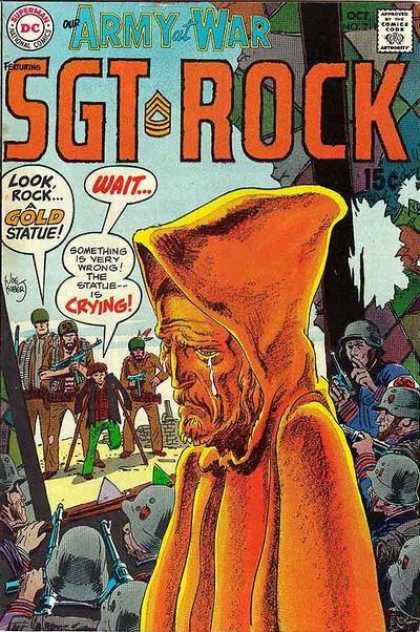 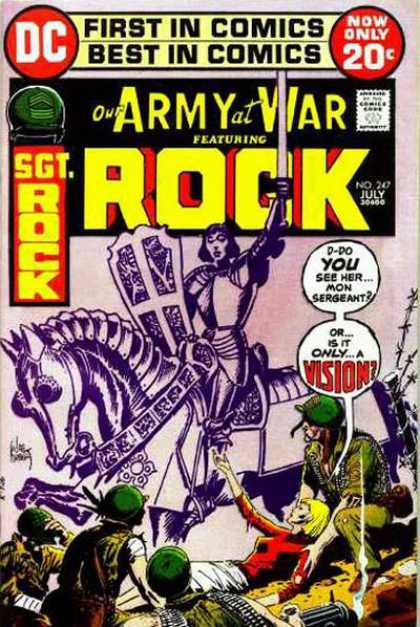 I recall that when the JLA story, "Miracle at 22,300 Miles" came out (1981) that it was the first time I'd ever seen Hanukkah used in a superhero story. And it was not at all mentioned as a holiday story on the cover...  Eventually, retcons gave us a Jewish Wild Man in Sgt. Rock, a Jewish Ray Palmer (IIRC), and Ben Grimm, etc., but I think there was a reasonable wariness among the pre- and post-WW2 comic creators about pushing the envelope too far. |
|
|
|
Post by codystarbuck on Jun 18, 2017 14:34:02 GMT -5
Our Fighting Forces #161 and 162   Our first story finds the Losers in Burma, tasked with setting up an observation post for the artillery, to intercept a Japanese advance. The wrinkle in the plan is a British major, who is plagued by nightmares of monsters, after his men were killed in a fight with the Japanese at the same temple ruins as the team's destination. 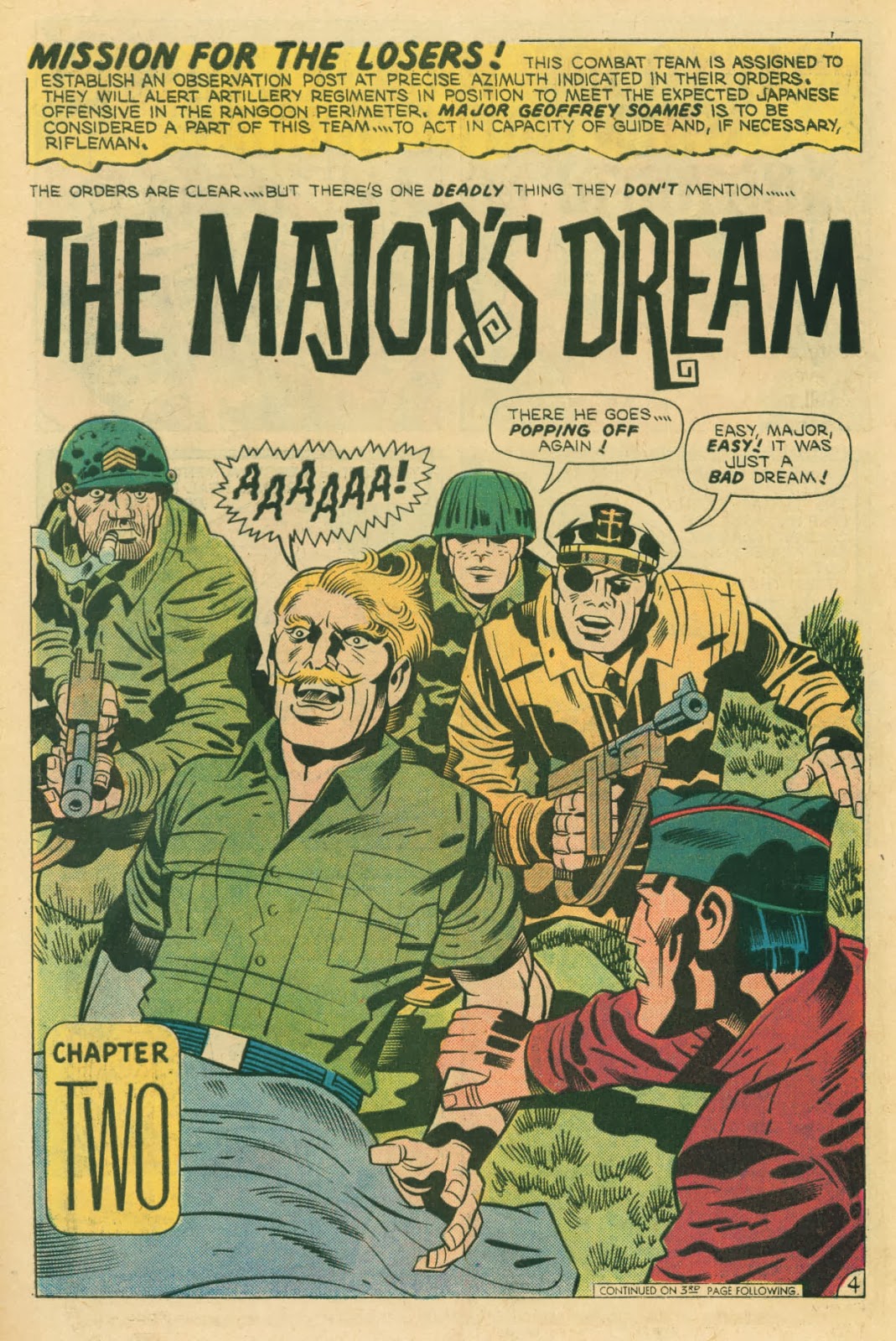 The major's agitation gets worse as they enter the ruins and he starts coming unglued completely when the shelling starts. He fights imaginary Japanese, though his actions help the Losers fight back Japanese soldiers who are taking cover in the temple.. Eventually, the major is killed by a cave-in. The story is hardly Kirby's best; but, it does illustrate the trauma of combat, especially to survivors of deadly battles. The major is plagued by monsters, based on totems in the old temple. They represent the forces that took his men; but, left him alive. He is torn by guilt for having lived, when they died. That guilt manifests as the nightmares. Kirby is said to suffer from recurring nightmares: one was being unable to produce work to feed his family, the other was about combat. Here, Kirby gives us a peek into the kinds of things he dealt with, when he closed his eyes. No less than Audie Murphy, America's most decorated soldier, spoke publicly about the nightmares and trauma he dealt with, after the war. he was one of the first to speak openly about the toll that combat took upon him and one of the most high profile. It let other veterans know that even the bravest of heroes still lived with the nightmares of what he had been through. These are the scars that never really heal. At best, the veterans make peace with the ghosts and nightmares and learn to get through the rough times. Vietnam veterans suffered heavily from PTSD and one theory as to why that generation seemed to face it more than the WW2 generation was that the soldiers of WW2 went home on troop ships and had time to leave the war behind, before actually arriving home. Vietnam-era vets were put on a plane home and arrived hours later, fresh from the jungles. Most had no transition time. However, as vets spoke out more in post-Vietnam America, older generations started to admit that they had had problems; but, their generation just never talked about it. Sometimes vets talked to each other, as they were the only ones who understood. One of the positive things to come out of this was support networks of veterans, who helped each other deal with the trauma. Unfortunately, these networks had to largely be built outside the VA system, as it has always been woefully underfunded and neglected. These same support groups have been instrumental in helping newly returning veterans of our recent wars, while the VA has gotten better about PTSD, but still lacks funds and Congressional attention to do their job right. Politicians like to talk about brave heroes in uniform; but, are also quick to forget about them at appropriation time. Once the photo op is over, what then? The general public his greatly improved from the Vietnam era, in recognizing veterans and service members for their sacrifices, even when they don't agree with the war they were called to fight. Sometimes the public overcompensates, like when people call a servicemember a hero, because they put on a uniform. Heroes are determined by actions, not clothing and occupation. Sometimes it feels embarrassing when someone who learns I am a vet makes a big deal about it. I was stateside, hunting down repair parts. It was my job. I'm proud to have done my part; but, I was and am no hero. To me, Audie Murphy is a hero; not for killing Germans, but for keeping his men alive. He was a kid, who became a non-com at 17. I started ROTC at 17; but, I wasn't a tenth of the leader he was. He'sa hero for being willing to wave off the talk of heroics and talk about the price he paid for his "heroics." Leaders like him make you step back a minute and rethink the necessity of sending troops into combat, rather than searching for a peaceful alternative, again. Our last story features a group of French kids, who Gunner is training to be Marines. The Losers are there to recon a potential German counter-offensive. 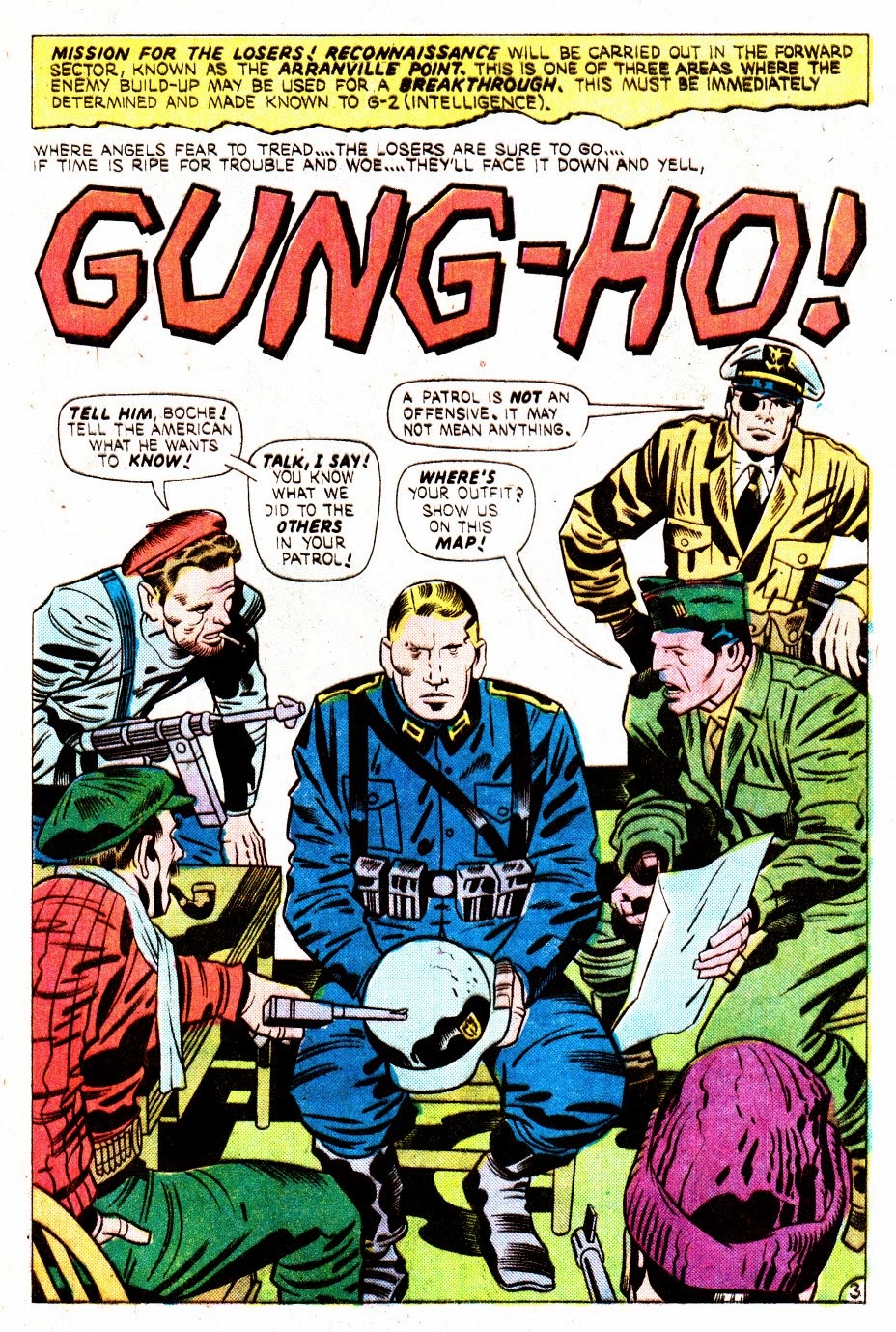 The Losers are working with the Free French and Storm, Cloud and Sarge are a bit chagrined by Gunner and his "Marines." As Sarge said, the kids should be in school and the war has taken a lot from them. They don't want to see these kids hurt any further, if the Germans do counter-attack. The prisoner won't talk, so the team goes on patrol. They run smack into a German advance and hole up with the Free French. The French fighters go down and things look bleak, as a panzer attacks. Gunner and his "Marines" fight from a trench. They are able to damage the tanks treads and put it out of commission. However, they fave a German assault and answer with fire and grenades, who Gunner unleashes a flamethrower. The Losers are able to get to their position and see the German probe thrown back by these brave kids and a young, crazy Marine. This is another typical war comic story. Sgt Fury had one with a young Dutch boy, who believes his father, the mayor, is a collaborator and wants to fight with the Howlers. The Howlers are meeting up with an agent of the Dutch resistance, who will help them pinpoint spots to plant explosives in the dykes, to halt the Germans. It turns out the agent is the boy's father. Simon & Kirby created the Boy Commandos, a team of kids from Allied territories, who fight the Germans. This has a similar feel, though with far greater seriousness. Children were often some of the first to aid in the resistance efforts, acting as lookouts and couriers. Many had lost family members and war orphans were a major subject during the war an dafter. In commentary tracks for Starship Troopers and Soldier of Orange, Paul Verhoeven has talked about his childhood in occupied Holland. He wasn't involved in fighting, but witnessed things like Allied bombers crashing, after being hit by anti-aircraft fire and German fighters, soup kitchens trying to feed the starving populace, whose crops had been taken by the Germans (a soup made with tulip bulbs), and similar sights. Children suffer the worst in war, as we see in pictures of Syrian refugees, as well as the child soldiers of Africa, who have been turned into killers by monsters. Kirby both highlights the bravery of these kids who have lost everything and the tragedy of their losses. They lost their childhood and learned to fight to survive. This brings an end to Jack Kirby, at DC, in the 1970s. Kirby had grown disenchanted with his treatment at DC and the broken promises. he was paid well, but had to churn out material. He had been promised control; but soon saw that evaporate. Still, he was a professional and a powerful creative force. Even his "failures" proved to be a cut above everything else. DC courted him because of the success of Marvel, but elements at the top treated him badly because of professional jealousy and rivalry. They set out to prove that DC had the better artists and pointed to the cancellation of Kirby's titles as proof. Kirby decided to head back to the devil he knew. However, even those jealous editors knew that Kirby's name meant more than most of the artists they had and continued to publish his work after he had returned to Marvel. Jack just moved forward, as was his way. Marvel would turn sour, too, and then bitter. Kirby would return to do some work at DC in the 80s, for a group of people who appreciated the work he had done and tried to rectify some of the mistreatment. Kirby was given retroactive creator royalties on the 4th World characters, for their use in the Super Friends cartoons and the Kenner toy line. DC wasn't contractually bound; they just did it. Granted, they didn't part with much; but, the Kirby's were pleased with the gesture and it wasn't small change. Unfortunately, Jack's health meant that his artwork wasn't what it once was and much of the material could only disappoint. Still, Jack spent the remainder of his life basking in the glow of fans and professionals who recognized his genius and his sacrifice. As Mark Evanier pointed out in his book, Jack and Roz knew he would never be forgotten. So, this chapter closes; but, I would like to open a new one, with Kirby's return to Marvel; and, especially, The Eternals. |
|
|
|
Post by Prince Hal on Jun 18, 2017 15:33:57 GMT -5
codystarbuck , nicely done as usual! Just a note on kid soldiers. In several issues of Our Army at War, beginning with #189 (on sale in December 1967), Robert Kanigher featured a group of teenaged French underground fighters, called Unit 3. IIRC, the reaction to them was generally meh at best. I have to say that I liked the Unit 3 appearances I read back then. They were as cliched as many of their predecessors in some wasy, but there was grittier aspect to their group, all of whom had lost their fathers in OAAW 189. Kanigher seemed to have been trying to play up the teenage angle that was popular at the time in the superhero books, as he featured Unit 3 in a cameo in 191 and as full-fledged co-stars in five more issues of OAAW and another of GI Combat between December of '67 and July of 1968. 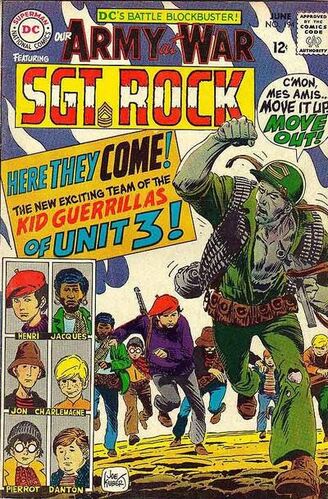
|
|
|
|
Post by mrbrklyn on Nov 5, 2018 21:23:06 GMT -5
As I covered in my 1st Issue Special Reviews, the series came to an end, with the relaunch of the 4th World.  DC once again gave Kirby's epic series a try, though without Kirby. At the heart of it seemed to be Gerry Conway, aided and abetted by Steve Engelhart, who weren't beyond trying their hands at Kirby's creations. The idea got a trial at 1st issue Special, where Mister Miracle and Barda joined Orion and the New Gods, except for a noticeably absent Lightray. One thing was obvious from the start, this was a more 'superhero" take on the idea. Orion got a more traditional superhero costume and mask, while barda left her armor in the closet. Metron seemed a bit more chummy with Highfather and the gang, than in past. Kalibak is back and Desaad would soon return. Just about everyone was brought back, except the Forever People and the Newsboy Legion and Jimmy Olsen. I guess Conway didn't care for those. His loss, if you ask me (well, maybe not the Forever People). He also didn't go straight to the New Gods, following 1st Issue Special #13. Conway started his run with a new book, Secret Society of Super-Villains:     These four issues reveal that Darkseid is behind a new grouping of supervillains, with the intent of using them, rather than Intergang, to conquer the Earth. We meet a Manhunter clone, who ends up leading a rebellion of the group, putting them at odds with Kalibak and Mantis, before facing Darkseid, himself. Manhunter sacrifices himself as a living boobytrap, stopping Darkseid's 1st attempt at new conquest. The issues themselves are a bit of a mixed bag. There is an intriguing story there; but, a rotating creative team made it hard to build any momentum and the art was never anything to write home about. We also don't get to see the characters fleshed out more, as they have about as much characterization as the average Challenge of the Superfriends episode. This was the highpoint for this short-lived series, a victim of the DC Implosion. They got a bit more life in JLA, where they swapped minds with the JLA members and were double-crossed by the Ultra-Humanite. They didn't again cross paths with Darkseid. Darkseid himself was still waiting in the wings and he would step out in 1977, when sci-fi was king. Next up, the relaunch begins in earnest! What is weird about this is that I don't know why DC published this. It seemed like it had no chance to sell. |
|
|
|
Post by codystarbuck on Nov 6, 2018 1:00:50 GMT -5
As I covered in my 1st Issue Special Reviews, the series came to an end, with the relaunch of the 4th World.  DC once again gave Kirby's epic series a try, though without Kirby. At the heart of it seemed to be Gerry Conway, aided and abetted by Steve Engelhart, who weren't beyond trying their hands at Kirby's creations. The idea got a trial at 1st issue Special, where Mister Miracle and Barda joined Orion and the New Gods, except for a noticeably absent Lightray. One thing was obvious from the start, this was a more 'superhero" take on the idea. Orion got a more traditional superhero costume and mask, while barda left her armor in the closet. Metron seemed a bit more chummy with Highfather and the gang, than in past. Kalibak is back and Desaad would soon return. Just about everyone was brought back, except the Forever People and the Newsboy Legion and Jimmy Olsen. I guess Conway didn't care for those. His loss, if you ask me (well, maybe not the Forever People). He also didn't go straight to the New Gods, following 1st Issue Special #13. Conway started his run with a new book, Secret Society of Super-Villains:     These four issues reveal that Darkseid is behind a new grouping of supervillains, with the intent of using them, rather than Intergang, to conquer the Earth. We meet a Manhunter clone, who ends up leading a rebellion of the group, putting them at odds with Kalibak and Mantis, before facing Darkseid, himself. Manhunter sacrifices himself as a living boobytrap, stopping Darkseid's 1st attempt at new conquest. The issues themselves are a bit of a mixed bag. There is an intriguing story there; but, a rotating creative team made it hard to build any momentum and the art was never anything to write home about. We also don't get to see the characters fleshed out more, as they have about as much characterization as the average Challenge of the Superfriends episode. This was the highpoint for this short-lived series, a victim of the DC Implosion. They got a bit more life in JLA, where they swapped minds with the JLA members and were double-crossed by the Ultra-Humanite. They didn't again cross paths with Darkseid. Darkseid himself was still waiting in the wings and he would step out in 1977, when sci-fi was king. Next up, the relaunch begins in earnest! What is weird about this is that I don't know why DC published this. It seemed like it had no chance to sell. I think there were some at DC who thought Kirby had some good ideas; but, wanted them to be more like standard comics and thought someone like Conway could give them more of a mainstream sheen. I'm sure that's how he probably pitched it, because the relaunch was very much in a superhero vein, compared to what Kirby had done. Englehart and Rogers had a better handle on the material, if you ask me. It wasn't Kirby; but, they did something interesting that didn't seem to go against what Kirby had done. Some of conway's stuff seemed further afield and off-model. I don't think he really had a decent handle on the 4th World until the JLA/JSA/New Gods crossover. There, he really seems to get it (especially with Perez's visuals adding to the visual impact). i love Don Newton's art and he did his best with what he had and did some interesting visuals; but, Conway wasn't giving him the same quality of script that Englehart was giving Rogers. I think it helps that Mister Miracle fits a bit more closely into the superhero world, than Orion, especially with the show biz angle, the escapes, and how the Apokolips characters were used. Conway seemed to get mostly whatever he wanted at DC; like they expected him to deliver Marvel sales, since he had been one of their high profile writers, before defecting. I think he delivered on soe of that; but, there was a lot where he didn't. Also, DC and Marvel were flooding newsstands, trying to find anything that would sell and to crowd the others out, as space dwindled. Soon after, DC had the Implosion and cut back and Marvel cancelled a bunch of titles around the same time; just not as many in one go. |
|
|
|
Post by berkley on Nov 6, 2018 6:04:50 GMT -5
I still haven't read any of the Conway New Gods but I plan to give them a try one of these days, caving in to my curiosity about anything that's done with Kirby's FW, much as I find myself doing with the Eternals at Marvel, no matter, it seems, how many times I'm disappointed.
It's a funny thing that even though Steve Englehart didn't think much of Kirby's writing in general, including the New Gods stuff, he still came up with one of the very few runs of interest on any of those characters. Englehart would probably hate what I'm about to say, but I see this as a case of a gifted creator's talent being smarter than his conscious brain.
Not that I discount the conscious work he put into making those two or three issues of Mister Miracle as good as he could make them - but somehow or other, even though they read very much as Steve Englehart stories and even though he didn't rate the original very highly, they feel more in tune with the spirit of Kirby's ideas than pretty much anything else I can think of, apart from a few exceptions (Gerber's follow-up on MM, Simonson's Orion, and ... that might be it).
|
|
|
|
Post by MWGallaher on Nov 6, 2018 9:03:15 GMT -5
Conway started his run with a new book, Secret Society of Super-Villains:     These four issues reveal that Darkseid is behind a new grouping of supervillains, with the intent of using them, rather than Intergang, to conquer the Earth. We meet a Manhunter clone, who ends up leading a rebellion of the group, putting them at odds with Kalibak and Mantis, before facing Darkseid, himself. Manhunter sacrifices himself as a living boobytrap, stopping Darkseid's 1st attempt at new conquest. The issues themselves are a bit of a mixed bag. There is an intriguing story there; but, a rotating creative team made it hard to build any momentum and the art was never anything to write home about. We also don't get to see the characters fleshed out more, as they have about as much characterization as the average Challenge of the Superfriends episode. This was the highpoint for this short-lived series, a victim of the DC Implosion. They got a bit more life in JLA, where they swapped minds with the JLA members and were double-crossed by the Ultra-Humanite. They didn't again cross paths with Darkseid. Darkseid himself was still waiting in the wings and he would step out in 1977, when sci-fi was king. Next up, the relaunch begins in earnest! What is weird about this is that I don't know why DC published this. It seemed like it had no chance to sell. If the question was about why DC published Secret Society of Super-Villains, I suspect it was at least partly to try to prevent Marvel from establishing an exclusive trademark to the term "Super-Villain." And there's some evidence that DC put out Return of the New Gods to force Marvel to rename Kirby's new Marvel creation, The Eternals, which was originally intended to be Return of the Gods. |
|